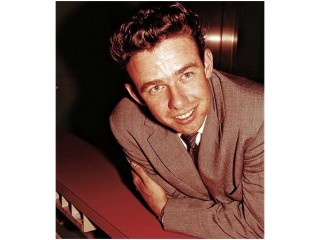
Dale Hawkins biography
Date of birth : 1936-08-22
Date of death : 2010-02-13
Birthplace : Gold Mine, Louisiana,U.S.
Nationality : American
Category : Famous Figures
Last modified : 2023-08-22
Credited as : singer-songwriter, rock musician and guitarist, blues evolution, sonic innovator
1 votes so far
Delmar Allen "Dale" Hawkins: The Architect of Sonic Adventure
In the heart of American rock 'n' roll, a trailblazer emerges with a guitar in hand, reshaping the rhythmic landscape. Delmar Allen "Dale" Hawkins, a pioneer of sonic exploration, was more than just a singer, songwriter, and rhythm guitarist. He was a creator of genres, a discoverer of talents, and an artist who dared to venture where others feared. From the sultry rhythms of the bayou to the electrifying boogie of swamp rock, Hawkins's legacy is etched in the annals of musical evolution.
The Unheralded Pioneer
Dale Hawkins, often overshadowed by rock 'n' roll's luminaries, left an indelible mark on the very fabric of the genre. His 1957 hit "Suzie Q" was a clarion call that resonated through the airwaves. Yet, Hawkins's contributions surpassed this single triumph, as he unraveled the architecture of sound itself. In the midst of rockabilly's heyday, Hawkins stood as an iconoclast, pushing boundaries and defying expectations.
The Chicago Odyssey
As one of the two white artists on the Checker label, a Chess subsidiary, Hawkins carved his niche within the vibrant tapestry of Chicago's music scene. Amid the bustling rhythm & blues records, Hawkins emerged as a key figure, driving innovation and collaboration. His collaborations with guitarists like James Burton, Roy Buchanan, Kenny Paulsen, and Carl Adams would go on to shape the future of rock 'n' roll's sonic landscape.
Rhythms of the Roots
Hawkins's childhood was a mix of musical influences, a symphony that transcended boundaries. Raised in Louisiana's racially mixed plantation, he imbibed the essence of country, blues, and gospel music. With a guitar purchased at age seven, he embarked on a journey guided by a harmonica code book and a voracious appetite for rhythm & blues.
A Baton Rouge Revelation
The It'll Do Club in Baton Rouge became Hawkins's crucible of sound, where young guitar prodigy James Burton and drummer A. J. Tuminello joined forces. A clerk at Stan's Record Shop, Hawkins's immersion in the world of rhythm & blues records would be a catalyst for his journey. Little did he know that his intimate knowledge of the genre would soon propel him to the forefront of the rock 'n' roll revolution.
"Suzie Q" and the Chess Saga
"Suzie Q," a fusion of snarling guitar riffs and an insistent cowbell, was the ignition of Hawkins's legacy. A deal with Checker, a Chess subsidiary, brought his electrifying sound to the masses. However, Leonard Chess's hesitance to release the record tested Hawkins's patience. Chuck Dunaway's intervention marked a turning point, propelling the song to national recognition. Hawkins's roots in rhythm & blues converged with rock 'n' roll, birthing a genre-defying anthem.
Beyond "Suzie Q"
Hawkins's journey did not stagnate with his hit single. His work at Checker oscillated between vibrant blues and vibrant pop. The rhythm & blues undercurrents remained, evident in tracks like "My Babe," "Tornado," and "Wild, Wild World." Hawkins's ability to unearth guitar virtuosos and his production prowess showcased his multi-faceted genius, enriching the sonic spectrum.
A Life Resurrected
Dale Hawkins's journey encountered turbulent waters, marked by personal struggles and battles with addiction. His moment of reckoning arrived in 1981, prompting him to make a choice between life and self-destruction. The path of sobriety led him to create crisis intervention programs for teenagers, adding a new chapter to his legacy of impact.
A Phoenix's Song
Hawkins's renaissance in the rockabilly revival circuit reignited his musical spirit. With a Hawk's Nest studio at his disposal, he returned to music's forefront. The post-Elvis era welcomed his return, and his resilience in the face of adversity inspired a new generation. His artistry blossomed anew, captivating audiences and shaping a narrative of revival.
The Final Bow
Dale Hawkins's legacy culminated with a curtain call that echoed through time. A survivor of colon cancer, his indomitable spirit never wavered. In 2010, the music world bid farewell to a pioneer whose footprints were etched in the rock 'n' roll sands. His influence transcended eras, and his journey remains a testament to the unbreakable bond between passion, resilience, and sonic evolution.
Delmar Allen "Dale" Hawkins's journey was a symphony that defied limits. From the bayous of Louisiana to the heart of Chicago's rhythm & blues, his music encompassed diversity and challenged convention. His legacy lies in the resounding chords that continue to reverberate through generations, a testament to an artist who shaped rock 'n' roll with an audacity that remains unmatched.
Selected discography:
-Suzie Q Checker, 1958; reissued, Argo, 1987.
-My Babe Checker, 1960; reissued, Argo, 1987.
-Let's All Twist at the Miami Beach Peppermint Lounge Roulette, 1962; reissued, Edsel, 2000.
-(With others) L.A., Memphis, and Tyler, Texas Bell, 1969.
-Dale Hawkins Chess, 1972.
-Daredevil Norton, 1997.
-Rock 'n' Roll Tornado Ace, 1998.
-Born in Louisiana Goofin', 1999.
-Wildcat Tamer Mystic, 1999.
-Fool's Paradise Beveric, 2000.
-Dale Hawkins Plumtone/e-music, 2001.
















